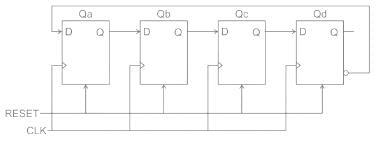Electrical Engineering (EE) Exam > Electrical Engineering (EE) Questions > A shift register with its complement output (...
Start Learning for Free
A shift register with its complement output (Q’) of the last stage connected to the D-input of the first stage is called:
- a)twisted-ring counter
- b)synchronous counter
- c)asynchronous counter
- d)up-counter
Correct answer is option 'A'. Can you explain this answer?
Most Upvoted Answer
A shift register with its complement output (Q’) of the last sta...
Ring counter:
The Ring shift counter is a recirculating register in which the serial output is connected back to the serial input as shown:


A Straight ring counter with ‘n’ flip-flops will have n states.
Johnson counter:
A Johnson counter is a modified ring counter, where the inverted output from the last flip flop is connected to the input to the first.
It is also called a twisted ring counter.
The MOD of the Johnson counter is 2n if n flip-flops are used.
The circuit diagram for a 4-bit Johnson Counter is as shown:

Free Test
FREE
| Start Free Test |
Community Answer
A shift register with its complement output (Q’) of the last sta...
Understanding Twisted-Ring Counter
A twisted-ring counter is a specific type of shift register configuration where the complement output of the last flip-flop stage is fed back into the first stage. This creates a unique behavior in the counting mechanism.
Key Features of Twisted-Ring Counter
- Feedback Mechanism: The last stage’s complement output (Q') is connected to the D-input of the first stage, which allows for a modified counting sequence.
- Counting Sequence: The feedback creates a pattern of binary counting that is not linear, resulting in a series of states that represent a cycle.
- State Representation: For an n-stage twisted-ring counter, there are 2^n possible states, but only n states are used in practice. This is because the nature of the feedback limits the number of valid states.
Applications of Twisted-Ring Counters
- Digital Circuit Design: Twisted-ring counters are commonly used in digital circuits for generating specific sequences, such as in sequence detectors or state machines.
- Synchronous Operation: Since all flip-flops in a twisted-ring counter can be clocked simultaneously, they operate in a synchronous manner, enhancing the stability and performance of the circuit.
Comparison with Other Counters
- Synchronous Counter: Unlike a twisted-ring counter, a synchronous counter counts in a straightforward binary manner without the unique feedback characteristic.
- Asynchronous Counter: An asynchronous counter does not have a direct feedback mechanism and relies on the propagation of clock signals, which can lead to delays.
Conclusion
Thus, the unique feedback mechanism and the resultant counting sequence characterize the twisted-ring counter, making it a distinct and valuable component in digital electronics.
A twisted-ring counter is a specific type of shift register configuration where the complement output of the last flip-flop stage is fed back into the first stage. This creates a unique behavior in the counting mechanism.
Key Features of Twisted-Ring Counter
- Feedback Mechanism: The last stage’s complement output (Q') is connected to the D-input of the first stage, which allows for a modified counting sequence.
- Counting Sequence: The feedback creates a pattern of binary counting that is not linear, resulting in a series of states that represent a cycle.
- State Representation: For an n-stage twisted-ring counter, there are 2^n possible states, but only n states are used in practice. This is because the nature of the feedback limits the number of valid states.
Applications of Twisted-Ring Counters
- Digital Circuit Design: Twisted-ring counters are commonly used in digital circuits for generating specific sequences, such as in sequence detectors or state machines.
- Synchronous Operation: Since all flip-flops in a twisted-ring counter can be clocked simultaneously, they operate in a synchronous manner, enhancing the stability and performance of the circuit.
Comparison with Other Counters
- Synchronous Counter: Unlike a twisted-ring counter, a synchronous counter counts in a straightforward binary manner without the unique feedback characteristic.
- Asynchronous Counter: An asynchronous counter does not have a direct feedback mechanism and relies on the propagation of clock signals, which can lead to delays.
Conclusion
Thus, the unique feedback mechanism and the resultant counting sequence characterize the twisted-ring counter, making it a distinct and valuable component in digital electronics.

|
Explore Courses for Electrical Engineering (EE) exam
|

|
Similar Electrical Engineering (EE) Doubts
Question Description
A shift register with its complement output (Q’) of the last stage connected to the D-input of the first stage is called:a)twisted-ring counterb)synchronous counterc)asynchronous counterd)up-counterCorrect answer is option 'A'. Can you explain this answer? for Electrical Engineering (EE) 2025 is part of Electrical Engineering (EE) preparation. The Question and answers have been prepared according to the Electrical Engineering (EE) exam syllabus. Information about A shift register with its complement output (Q’) of the last stage connected to the D-input of the first stage is called:a)twisted-ring counterb)synchronous counterc)asynchronous counterd)up-counterCorrect answer is option 'A'. Can you explain this answer? covers all topics & solutions for Electrical Engineering (EE) 2025 Exam. Find important definitions, questions, meanings, examples, exercises and tests below for A shift register with its complement output (Q’) of the last stage connected to the D-input of the first stage is called:a)twisted-ring counterb)synchronous counterc)asynchronous counterd)up-counterCorrect answer is option 'A'. Can you explain this answer?.
A shift register with its complement output (Q’) of the last stage connected to the D-input of the first stage is called:a)twisted-ring counterb)synchronous counterc)asynchronous counterd)up-counterCorrect answer is option 'A'. Can you explain this answer? for Electrical Engineering (EE) 2025 is part of Electrical Engineering (EE) preparation. The Question and answers have been prepared according to the Electrical Engineering (EE) exam syllabus. Information about A shift register with its complement output (Q’) of the last stage connected to the D-input of the first stage is called:a)twisted-ring counterb)synchronous counterc)asynchronous counterd)up-counterCorrect answer is option 'A'. Can you explain this answer? covers all topics & solutions for Electrical Engineering (EE) 2025 Exam. Find important definitions, questions, meanings, examples, exercises and tests below for A shift register with its complement output (Q’) of the last stage connected to the D-input of the first stage is called:a)twisted-ring counterb)synchronous counterc)asynchronous counterd)up-counterCorrect answer is option 'A'. Can you explain this answer?.
Solutions for A shift register with its complement output (Q’) of the last stage connected to the D-input of the first stage is called:a)twisted-ring counterb)synchronous counterc)asynchronous counterd)up-counterCorrect answer is option 'A'. Can you explain this answer? in English & in Hindi are available as part of our courses for Electrical Engineering (EE).
Download more important topics, notes, lectures and mock test series for Electrical Engineering (EE) Exam by signing up for free.
Here you can find the meaning of A shift register with its complement output (Q’) of the last stage connected to the D-input of the first stage is called:a)twisted-ring counterb)synchronous counterc)asynchronous counterd)up-counterCorrect answer is option 'A'. Can you explain this answer? defined & explained in the simplest way possible. Besides giving the explanation of
A shift register with its complement output (Q’) of the last stage connected to the D-input of the first stage is called:a)twisted-ring counterb)synchronous counterc)asynchronous counterd)up-counterCorrect answer is option 'A'. Can you explain this answer?, a detailed solution for A shift register with its complement output (Q’) of the last stage connected to the D-input of the first stage is called:a)twisted-ring counterb)synchronous counterc)asynchronous counterd)up-counterCorrect answer is option 'A'. Can you explain this answer? has been provided alongside types of A shift register with its complement output (Q’) of the last stage connected to the D-input of the first stage is called:a)twisted-ring counterb)synchronous counterc)asynchronous counterd)up-counterCorrect answer is option 'A'. Can you explain this answer? theory, EduRev gives you an
ample number of questions to practice A shift register with its complement output (Q’) of the last stage connected to the D-input of the first stage is called:a)twisted-ring counterb)synchronous counterc)asynchronous counterd)up-counterCorrect answer is option 'A'. Can you explain this answer? tests, examples and also practice Electrical Engineering (EE) tests.

|
Explore Courses for Electrical Engineering (EE) exam
|

|
Signup to solve all Doubts
Signup to see your scores go up within 7 days! Learn & Practice with 1000+ FREE Notes, Videos & Tests.


























